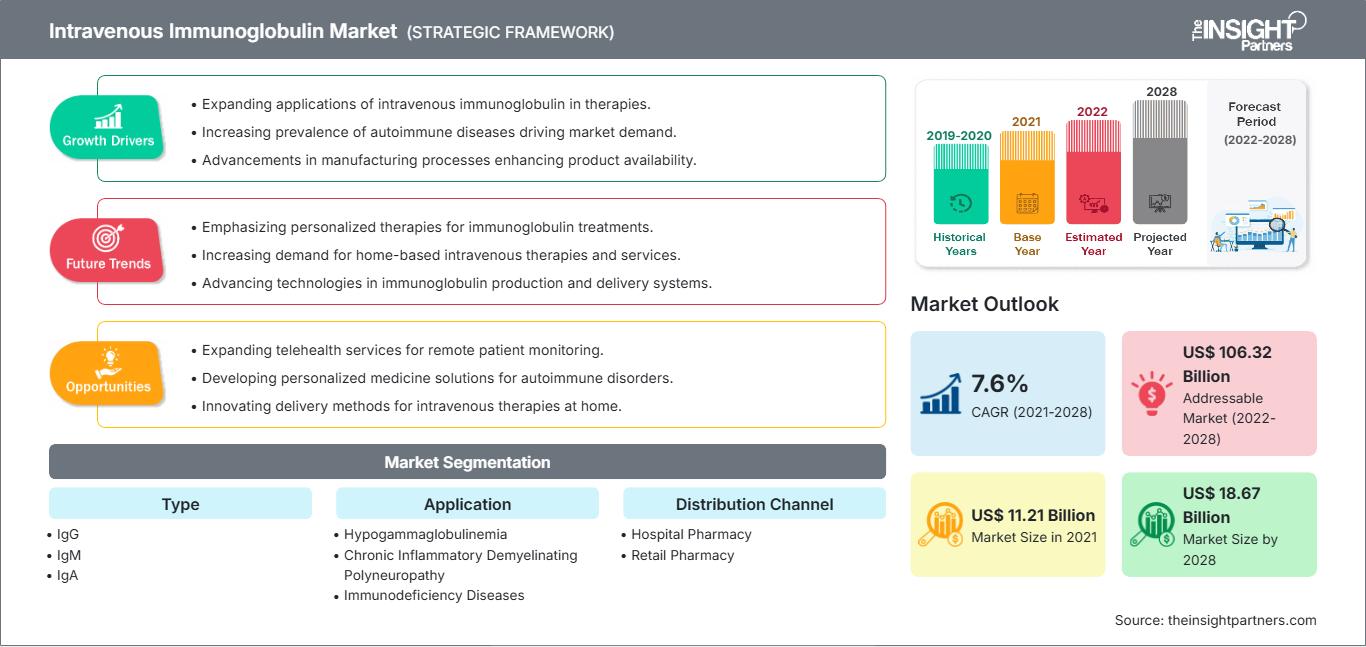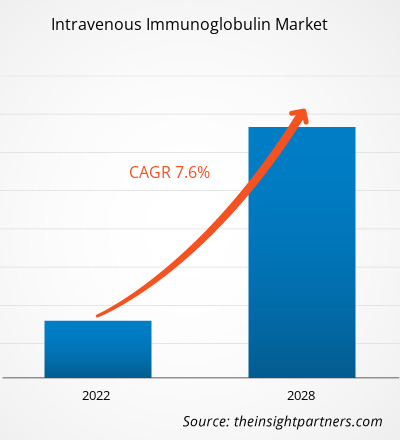The intravenous immunoglobulin market was valued at US$ 11,206.54 million in 2021 and is likely to reach to a value of US$ 18,672.55 million by 2028; it is estimated to grow at a CAGR of 7.6% from 2022 to 2028.
Immunoglobulins are the antibodies produced naturally by the body’s immune system, which help fight infection and disease. The deficiency of immunoglobulin requires the external administration of immunoglobulin and is known as immunoglobulin replacement therapy (IgRT). IgRT can be given intravenously and subcutaneously. Intravenous immunoglobulin (IVIg) and subcutaneous immunoglobulin (SCIg) are selected based on the indication and severity. IVIg is manufactured from human plasma. It contains antibodies and is used to treat a growing number of immunologic, hematologic, and neurologic illnesses.
The intravenous immunoglobulin market is segmented into type, application, distribution channel, end user, and geography. By geography, the market is broadly segmented into North America, Europe, Asia Pacific, the Middle East & Africa, and South & Central America. This report offers insights and in-depth analysis of the market, emphasizing parameters, such as market trends, market dynamics, and the competitive analysis of the globally leading market players.
Customize This Report To Suit Your Requirement
You will get customization on any report - free of charge - including parts of this report, or country-level analysis, Excel Data pack, as well as avail great offers and discounts for start-ups & universities
Intravenous Immunoglobulin Market: Strategic Insights

-
Get Top Key Market Trends of this report.This FREE sample will include data analysis, ranging from market trends to estimates and forecasts.
Market Insights
Rising prevalence of immunodeficiency diseases and increasing geriatric population is driving the intravenous immunoglobulin market.
According to the National Institute of Allergy and Infectious Diseases (NIAID), over 200 different types of primary immune deficiency diseases (PIDDs) affect about 500,000 people in the US. The rare genetic diseases can be chronic, weak, and expensive. Immune Thrombocytopenia (ITP) is an autoimmune bleeding disorder characterized by abnormally low levels of platelets; a situation referred to as thrombocytopenia. According to the Rare Diseases Organization, around 200,000 ITP cases are recorded worldwide annually. Further, according to the United Nations Population Division, World Population Prospects 2019, Asian and European countries have some of the world’s oldest populations aged 65 and over. Japan is at the top with 28%, followed by Italy at 23%. Further, Finland, Portugal, and Greece are among the top five countries with an aged population under 22%. Many of the patients treated with IVIG are above the age of 60 years. With aging, the ability to produce T-cells to fight diseases gets significantly reduced. Thus, an older person’s body is easily prone to several infections and diseases, which increases the demand for immune therapies that involve the use of IVIg. Thus, the rise in immunodeficiency diseases and increasing geriatric population across the globe is bolstering the intravenous immunoglobulin market.
Type-Based Insights
Based on the type, the intravenous immunoglobulin market is segmented into IgG, IgM, IgA, IgE, and IgD. The IgG type immunoglobulin segment held the largest market share in 2021. However, the handheld segment is anticipated to register the highest CAGR during the forecast period owing to its wide application of IgG in treating several categories of disorders.
Application-Based Insights
Based on application, the intravenous immunoglobulin market is segmented into hypogammaglobulinemia, chronic inflammatory demyelinating polyneuropathy, immunodeficiency diseases, myasthenia gravis, multifocal motor neuropathy, idiopathic thrombocytopenic purpura, inflammatory myopathies, specific antibody deficiency, Guillain-Barre syndrome, and others. In 2021, the immunodeficiency diseases segment held the market's largest share. Moreover, the same segment is expected to witness growth in its demand at the fastest CAGR from 2022 to 2028 due to the rising prevalence of immunodeficiency diseases and increasing FDA approvals for IVIg products to treat immunodeficiency.
Distribution Channel-Based Insights
Based on distribution channel, the intravenous immunoglobulin market is segmented into hospital pharmacy, retail pharmacy, and others. In 2021, the hospital pharmacy segment held the largest share of the market. Further, the retail pharmacy segment is expected to witness growth in its demand at the fastest CAGR from 2022 to 2028, owing to the expansions of retail pharmacies and the shift of consumer behavior towards organized retail pharmacies that offer high-quality drugs and medicines.
End User-Based Insights
Based on end user, the intravenous immunoglobulin market is segmented into hospitals, specialty clinics, and others. In 2021, the hospitals segment held the largest share of the market. Further, the specialty clinics segment is expected to witness growth in demand at the fastest CAGR from 2022 to 2028, owing to the advances in specialty clinics for offering quick and accurate IgRT to patients.
Organic developments such as product approvals are highly adopted strategies by the global intravenous immunoglobulin market players. A few of the recent key market developments are listed below:
- In March 2022, ADMA Biologics, Inc. announced the United States Food and Drug Administration’s (FDA) approval to extend the expiration dating from 24 to 36 months for both its ASCENIV and BIVIGAM immune globulin (“IG”) drug product stored at 2-8°C. The expiration date extension applies to all existing ASCENIV and BIVIGAM lots currently in the commercial supply chain as well as to future production of ASCENIV and BIVIGAM in all vial sizes, production scales as well as internal and external fill-finished drug product.
- In June 2021, Octapharma announced that octagam 10%, a human plasma-derived intravenous immunoglobulin (IVIg), has recently been granted approval in the European Union (EU) as an immunomodulatory therapy for adults with dermatomyositis. Following the EU approval, octagam 10% received national approval in Germany on May 11, 2021, with approval in other European member states expected soon.
- In April 2021, ADMA Biologics, Inc. announced that the U.S. Food and Drug Administration (“FDA”) approved the Company’s expanded manufacturing process, enabling fractionation and purification of a 4,400-liter plasma pool for the manufacture of Intravenous Immune Globulin (“IVIG”).
- In February 2020, CSL Behring announced that the U.S. Food and Drug Administration (FDA) granted Privigen (Immune Globulin Intravenous (Human), 10% Liquid) orphan-drug designation as an investigational therapy in the treatment of Systemic Sclerosis (SSc).
Such developments by market players are driving the intravenous immunoglobulin market.
Intravenous Immunoglobulin Market Regional InsightsThe regional trends and factors influencing the Intravenous Immunoglobulin Market throughout the forecast period have been thoroughly explained by the analysts at The Insight Partners. This section also discusses Intravenous Immunoglobulin Market segments and geography across North America, Europe, Asia Pacific, Middle East and Africa, and South and Central America.
Intravenous Immunoglobulin Market Report Scope
| Report Attribute | Details |
|---|---|
| Market size in 2021 | US$ 11.21 Billion |
| Market Size by 2028 | US$ 18.67 Billion |
| Global CAGR (2021 - 2028) | 7.6% |
| Historical Data | 2019-2020 |
| Forecast period | 2022-2028 |
| Segments Covered |
By Type
|
| Regions and Countries Covered |
North America
|
| Market leaders and key company profiles |
|
Intravenous Immunoglobulin Market Players Density: Understanding Its Impact on Business Dynamics
The Intravenous Immunoglobulin Market is growing rapidly, driven by increasing end-user demand due to factors such as evolving consumer preferences, technological advancements, and greater awareness of the product's benefits. As demand rises, businesses are expanding their offerings, innovating to meet consumer needs, and capitalizing on emerging trends, which further fuels market growth.

- Get the Intravenous Immunoglobulin Market top key players overview
Intravenous Immunoglobulin – Market Segmentation
The global intravenous immunoglobulin market is segmented into type, application, distribution channel, end user, and geography. Based on type, the market is segmented into IgG, IgM, IgA, IgE, and IgD). By Application, the market is segmented into hypogammaglobulinemia, chronic inflammatory demyelinating polyneuropathy, immunodeficiency diseases, myasthenia gravis, multifocal motor neuropathy, idiopathic thrombocytopenic purpura, inflammatory myopathies, specific antibody deficiency, Guillain-Barre syndrome, and others. Based on distribution channel, the market is segmented into hospital pharmacy, retail pharmacy, and others. By End User, the market is segmented into hospitals, specialty clinics, and others. By geography, the market is segmented into North America, Europe, Asia Pacific, Middle East & Africa, and South & Central America.
Company Profiles
- Takeda Pharmaceutical Company Limited
- Grifols, S.A.
- Pfizer Inc.
- ADMA Biologics Inc.
- Bio Products Laboratory Ltd.
- Shanghai RAAS
- Octapharma AG
- Kedrion S.p.A
- CSL Behring (CSL Limited)
- Prothya Biosolutions B.V.
Frequently Asked Questions
Who are the key players in the intravenous immunoglobulin market?
Which region is fastest growing?
Which segment led the intravenous immunoglobulin market?
What are intravenous immunoglobulins?
- Historical Analysis (2 Years), Base Year, Forecast (7 Years) with CAGR
- PEST and SWOT Analysis
- Market Size Value / Volume - Global, Regional, Country
- Industry and Competitive Landscape
- Excel Dataset
Recent Reports
Testimonials
Reason to Buy
- Informed Decision-Making
- Understanding Market Dynamics
- Competitive Analysis
- Identifying Emerging Markets
- Customer Insights
- Market Forecasts
- Risk Mitigation
- Boosting Operational Efficiency
- Strategic Planning
- Investment Justification
- Tracking Industry Innovations
- Aligning with Regulatory Trends





















 Get Free Sample For
Get Free Sample For